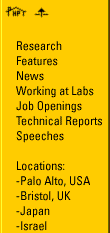HP Labs Technical Reports
Click here for full text:

Compressing Images for the Internet
Beretta, Giordano
HPL-97-163
Keyword(s): World Wide Web; Internet; image encoding; data compression; JPEG; GIF; PNG; FlashPix
Abstract: The World Wide Web has rapidly become the hot new mass communication medium. Content creators are using similar design and layout styles as in printed magazines, i.e., with many color images and graphics. The information is transmitted over plain telephone lines, where the speed/price trade-off is much more severe than in the case of printed media. The standard design approach is to use plattized color and to limit as much as possible the number of colors used, so that the images can be encoded with a small number of bits per pixel using the Graphics Interchange Format (GIF) file format. The World Wide Web standards contemplate a second data encoding method (JPEG) that allows color fidelity but usually performs poorly on text, which is a critical element of information communicated on this medium. We analyze the spatial compression of color images and describe a methodology for using the JPEG method in a way that allows a compact representation while preserving full color fidelity.
10 Pages
Back to Index
| 



